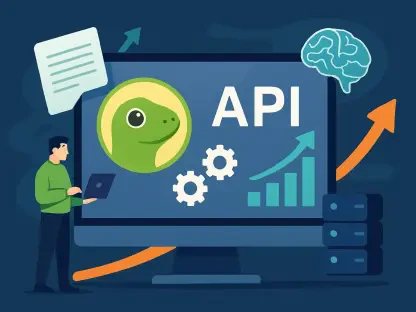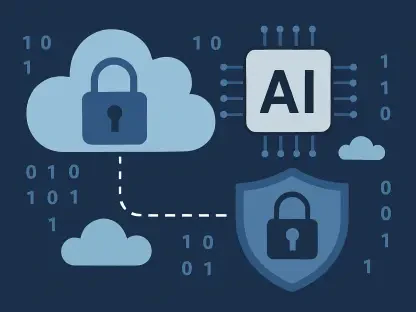The alarming statistic that 70% of Australian organizations feel overwhelmed by the rapid advancements in AI signals a critical urgency to evolve cybersecurity strategies. As AI evolves, it becomes both a boon and a bane for cybersecurity efforts, presenting advanced threats that traditional mechanisms struggle to counter. This scenario demands innovative solutions that integrate security more deeply into the software development process, resulting in a growing emphasis on AI-powered DevSecOps to safeguard against these modern and sophisticated threats.
The Challenge of Modern Cyber Threats
Increasing Complexity of Cyber Threats
The unprecedented complexity of modern cyber threats driven by AI advancements has left many Australian organizations grappling to keep their defenses intact. As AI technologies continue to improve, so do the capabilities of malicious actors who leverage them for nefarious purposes. This has led to an escalating arms race in the digital realm where traditional strategies are increasingly insufficient. With cyber threats becoming more sophisticated and targeted, organizations find themselves in dire need of robust solutions that can keep pace with these rapid advancements.
Organizations are compelled to rethink their cybersecurity strategies and reconsider their approach to integrated security solutions. AI-powered DevSecOps emerges as a proactive defense mechanism by embedding security measures early within the software development lifecycle. By doing so, organizations can detect and mitigate potential risks long before they manifest, ensuring a more resilient and secure infrastructure capable of withstanding the evolving threat landscape. This paradigm shift in cybersecurity strategy is not merely a recommendation but an urgent necessity to ensure continued protection in an AI-driven world.
Traditional DevOps Limitations
The limitations of traditional DevOps become glaringly evident when pitted against the rapid advancements in AI and the sophisticated threats they bring. While DevOps effectively streamlines the collaboration between development and IT operations, it often relegates security to the background, dealing with vulnerabilities only after they arise. This reactive approach is no longer sustainable in a landscape where threats evolve at breakneck speeds, and AI-driven attacks can exploit even minute vulnerabilities instantaneously. Hence, integrating AI into DevSecOps is not just an enhancement but a critical evolution of cybersecurity practices.
AI-powered DevSecOps offers a holistic solution to these limitations by seamlessly merging development, security, and IT operations into a cohesive unit. With AI at its core, this integrated approach brings numerous benefits, from enhanced security rigor to increased operational efficiency. AI-powered processes automate redundant tasks, enabling skilled engineers to focus on more strategic aspects of security and innovation. Furthermore, earlier integration of automated security checks within the development lifecycle ensures that vulnerabilities are spotted and remediated sooner, resulting in more secure and reliable software products.
Benefits of AI-Powered DevSecOps
Early Integration of Security
One of the most significant advantages of AI-powered DevSecOps is the early and automated integration of security within the development process. By embedding security from the onset, organizations can break down the traditional silos that exist between development, quality assurance, and security teams. This amalgamation fosters a collaborative environment where vulnerabilities are identified and addressed early in the software lifecycle, minimizing the risk of costly security breaches down the line. The proactive nature of this integration ensures that security is not an afterthought but an intrinsic part of the development journey.
Moreover, the early identification and remediation of vulnerabilities translate to tangible cost savings and efficiency gains. When security measures are incorporated during the initial stages of development, organizations can avoid the substantial expenses associated with fixing issues post-deployment. By catching vulnerabilities early, the cumulative impact on the project’s overall timeline and quality is significantly reduced. This integrated approach also promotes greater transparency and communication among teams, fostering an ethos of collective responsibility towards security and quality.
Improved Efficiency and Reduced Technical Debt
AI-driven DevSecOps dramatically improves efficiency by automating repetitive and mundane tasks that would traditionally require human intervention. This automation enables engineers and developers to dedicate their efforts to more complex and innovative challenges, driving the overall productivity and creativity of the team. By delegating routine security checks and tests to AI-powered tools, organizations can ensure a consistent and rigorous standard of security without compromising on speed or scalability. This leads to the development of more robust and resilient software, reducing the risk of vulnerabilities slipping through the cracks.
The concept of technical debt, the future cost of implementing quick and suboptimal solutions in the present, is one that continuously plagues software development teams. When under time pressure, teams often forgo extensive testing, accumulating technical debt that poses significant risks in the long term. AI-powered DevSecOps effectively manages this debt by automating continuous code scanning, identifying inefficiencies, and uncovering vulnerabilities as soon as they are introduced. This continuous scrutiny ensures that the codebase remains clean and secure, minimizing the cost and effort required for future maintenance and enhancements.
Addressing Technical Debt
Continuous Scanning and Detection
Addressing technical debt is a pivotal aspect of maintaining a secure and efficient software development pipeline. Technical debt accrues when teams opt for quick solutions instead of thorough, robust implementations, often under time constraints. This accumulating debt can compromise the system’s overall integrity and security, leading to vulnerabilities and inefficiencies that are costly to resolve later. AI-powered DevSecOps tackles this issue head-on by implementing continuous scanning and detection mechanisms that operate throughout the development lifecycle. These automated scans identify code inefficiencies and potential vulnerabilities as they arise, ensuring they are remedied promptly.
Continuous scanning and detection not only help in maintaining a cleaner codebase but also play a crucial role in embedding a culture of proactive security within the organization. By catching issues early and often, teams can address them before they escalate into significant problems that require substantial effort and resource allocation. The continuous nature of these scans ensures that security is an ongoing priority, rather than a one-time checkpoint. This approach reduces the technical debt and upholds the software’s quality and reliability, making it more resilient against future threats and challenges.
Proactive Culture of Improvement
The adoption of AI-powered DevSecOps goes beyond mere technical improvements; it fosters a proactive culture of continuous improvement and security awareness within development teams. As teams witness the benefits of automated testing and early detection, they become more inclined to prioritize thorough and meticulous coding practices. This shift in mindset helps instill a sense of responsibility towards maintaining high standards of security and quality consistently. With AI-driven tools providing actionable insights and prioritizing critical issues, teams are better equipped to make informed decisions, enhancing their overall effectiveness and productivity.
A proactive culture of continuous improvement is essential in navigating the dynamic landscape of cybersecurity challenges. Organizations that embrace AI-powered DevSecOps are better positioned to stay ahead of the curve, as they continuously refine and enhance their security practices based on real-time feedback and insights. This culture not only mitigates current risks but also empowers teams to innovate and explore new solutions confidently. By embedding a continuous improvement mindset, organizations ensure long-term resilience and agility, crucial for thriving amidst the ever-evolving threat landscape.
The Escalating Role of AI in Cybersecurity
AI as a Tool for Cybercriminals
The immense potential of AI in cybersecurity is undeniable, but it also presents significant risks as cybercriminals increasingly leverage AI for malicious purposes. AI has become a formidable tool in the hands of these adversaries, enabling them to identify targets with precision and conduct advanced attacks more effectively. According to the Annual Cyber Threat Report from the Australian Signals Directorate, there is a worrying trend of malicious actors utilizing AI to develop sophisticated attack strategies. This rapid escalation in AI-driven threats necessitates a heightened and adaptive approach to cybersecurity, compelling organizations to remain vigilant and well-equipped.
Cybercriminals exploiting AI can automate intricate tasks, craft personalized phishing emails, develop deepfake videos, and even engage in model stealing and data poisoning. These AI-powered attacks adapt and evolve, making them increasingly challenging to detect and counter. The sophistication and diversity of these threats highlight the urgent need for robust defensive measures that can anticipate and neutralize such attacks. As AI continues to augment the capabilities of cybercriminals, organizations must recognize the critical importance of integrating AI into their cybersecurity frameworks to effectively counter these advanced threats.
AI-Powered Attacks and Defensive Measures
The evolving threat landscape, marked by AI-powered attacks, demands equally advanced and adaptive defensive measures. AI-powered defensive mechanisms can detect subtle anomalies in user behavior or network traffic, providing a critical layer of protection against sophisticated attacks. Implementing AI within a DevSecOps framework enables continuous monitoring and real-time threat analysis, ensuring that potential breaches are identified and addressed at the earliest opportunity. For instance, AI-based fraud detection systems in the banking industry have been instrumental in identifying and blocking AI-generated synthetic identities, preventing fraudulent activities before they can cause significant damage.
These AI-driven defensive measures are indispensable in staying ahead in the ongoing cybersecurity arms race. By leveraging AI, organizations can create more resilient security infrastructures capable of adapting to evolving threats. Continuous learning and improvement from real-time data enable these systems to become more adept at identifying novel attack vectors and preempting potential breaches. As cyber threats continue to grow in sophistication and frequency, the reliance on AI-powered defensive solutions will become increasingly imperative, ensuring organizations are not caught off guard by the advancements in cybercriminal tactics.
Adoption of AI-Driven DevSecOps
Necessity for Businesses
In the face of escalating AI-driven cyber threats, the adoption of AI-powered DevSecOps has become a necessity for businesses striving to maintain robust cybersecurity defenses. The integration of AI within DevSecOps frameworks equips organizations with the tools needed to detect and mitigate threats proactively. This adoption is not just about enhancing security but also about ensuring that businesses remain competitive and resilient in an increasingly interconnected digital landscape. AI-powered security solutions can analyze vast amounts of data in real time, identifying patterns and anomalies that would be difficult for human analysts to detect, thus providing a crucial layer of protection.
For businesses, the strategic implementation of AI-powered DevSecOps can lead to significant competitive advantages. By optimizing security processes and reducing the time needed for threat detection and response, organizations can allocate more resources towards innovation and growth. This proactive approach to security fosters customer trust and loyalty by demonstrating a commitment to safeguarding sensitive data and ensuring the integrity of business operations. As AI continues to shape the cybersecurity landscape, businesses that embrace these advancements will be better positioned to navigate potential threats and seize new opportunities.
Market Projections and Trends
The startling statistic that 70% of Australian organizations feel overwhelmed by the rapid advancements in AI signifies a critical need to adapt cybersecurity strategies urgently. As AI progresses, it serves as both a tremendous asset and a substantial risk for cybersecurity defenses. Traditional methods are increasingly inadequate against the advanced threats posed by emerging AI technology. This evolving landscape necessitates innovative solutions that entwine security measures more deeply within the software development lifecycle. Consequently, there’s a heightened focus on AI-powered DevSecOps, which aims to protect against these modern and sophisticated threats more effectively. By integrating security practices seamlessly throughout the development process, organizations hope to counteract the growing complexity and ingenuity of AI-driven cyber threats. This integrated approach is seen as imperative to maintain resilience in the face of rapidly advancing technological landscapes.









